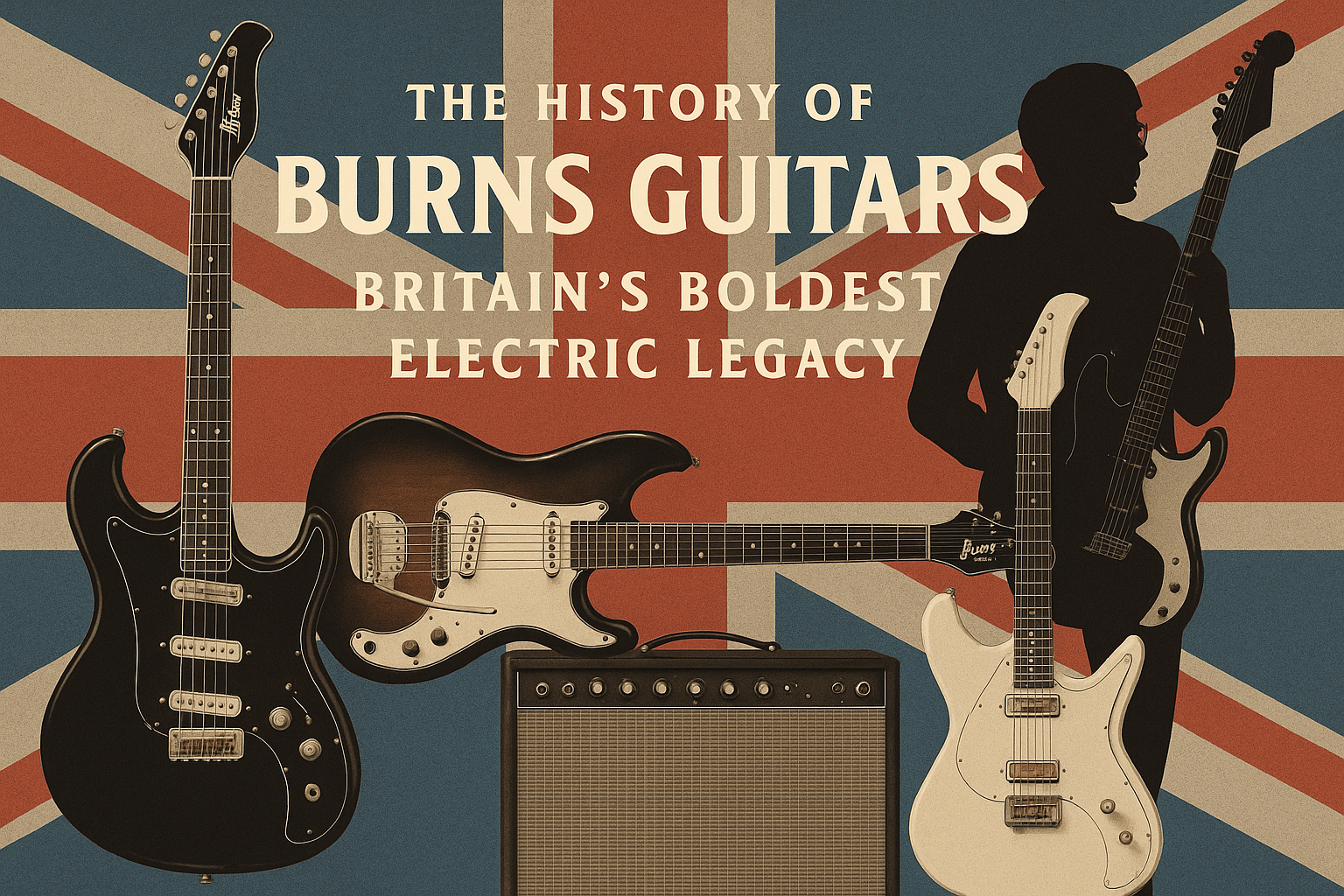Origins & the Vision of Jim Burns
Burns Guitars traces its roots to James Ormston “Jim” Burns (1925–1998), often hailed as the “British Leo Fender” for his inventive spirit and drive to build uniquely British electric guitars.
He began tinkering with guitars in the 1950s. His first six‑string sale was in 1952, and by the late 1950s he was experimenting seriously with solid-body electrics.
In 1959, Burns established Ormston Burns Ltd., after splitting from earlier collaborations (e.g. Burns‑Weill).
From the start, Burns was focused on distinctive design innovations: for example, early models featured a heel-less neck joint (i.e. smooth transition between body and neck) and sometimes even 24-fret fingerboards, which were forward-thinking for the time.
By the mid‑1960s, Burns was one of the major guitar makers in the UK, with growing influence in Europe as well.
Key Eras, Ownerships & Revivals
The Burns brand has gone through several incarnations, revivals, and corporate changes. Here’s a rough timeline:
|
Period |
Key Events & Characteristics |
|---|---|
|
1959–mid 1960s |
The founding era — inventive models, experimentation, establishing a British guitar identity. |
|
Mid‑1960s: Baldwin era |
Burns was acquired by Baldwin (an American piano/instrument company). During this period, Burns guitars were sometimes branded “Baldwin Burns” or associated with distribution in the U.S. |
|
Late 1960s: Ormston & transitional phase |
Jim Burns, no longer able to use the “Burns” name under Baldwin’s control, formed Ormston in 1966 to explore new guitar designs (especially pedal steel instruments) . He also experimented with designs that would later influence the Hayman line. |
|
1974–1977: Burns UK Ltd. |
With use of the Burns name restored, Burns UK produced radical new models like the Flyte, Mirage, Artist, and LJ24, often with bodies made by Shergold. |
|
1979–1983: Jim Burns Actualizers Ltd |
Jim Burns launched this venture, offering models like Steer, Scorpion, Magpie, Bandit, and revived versions of the Bison and Marvin. |
|
1992 onwards: Burns London revival |
Barry Gibson reactivated the brand in 1992 as Burns London, aiming to produce faithful reissues of classic models while also innovating. In recent years, Burns has relaunched under new ownership (in 2020, the brand was sold to a UK music retail consortium). |
Throughout these phases, certain hallmark features persisted — such as Burns’s vibrato systems, switching schemes (like “Split Sound”), and the distinctive Tri-Sonic pickups.
Signature & Famous Models
Over the decades, Burns produced many models, but a few stand out as particularly influential or iconic.
Artist / Vibra‑Artist
One of the earliest models (late 1950s / early 1960s). The Artist was a short-scale design; the Vibra-Artist added a vibrato arm and additional pickups.
Bison
Probably the most visually striking and ambitious Burns design, introduced around 1961. The original Bison had four pickups, a sculpted double-cut body, advanced vibrato, and elaborate switching. Later variants trimmed it down to three pickups, and added features like a “Wild Dog” tonal preset.
Some consider the Bison to be one of Jim Burns’s most refined designs.
Split Sound / Jazz Split Sound
The Split Sound electronics (switching between series/parallel, “split” and combined pickup modes) became a hallmark. The Jazz Split Sound is one of the clearer expressions of that design.
Marvin
Marvin is another core name in the Burns line. In the Burns London revival period, reissues of the Marvin were part of the “Custom Elite” range.
Flyte
From the mid‑1970s Burns UK period: the Flyte had a futuristic, angular body (some say inspired by the Concorde).
Steer, Scorpion, Magpie, Bandit
These were part of the Jim Burns Actualizers era. The Steer model gained some attention (Billy Bragg reportedly used one).
Contemporary & Special Models
In more recent years, Burns (under Burns London) has produced new models (and signature editions). For example:
-
Brian May Signature / Brian May / Red Special — Burns collaborated with Brian May to produce a signature model inspired by May’s famed Red Special, using the Burns Tri-Sonic pickups.
-
SSJ range — Short Scale Jazz models including 6-string, 12-string, and Bass‑VI designs.
Notable Players & Influences
Burns guitars and features have found their way into the hands of a number of influential musicians, and even indirectly shaped landmark instruments.
-
Hank Marvin / The Shadows
Perhaps the most famous Burns endorsement in the 1960s. Marvin was known to use Burns instruments, helping raise their profile in the UK.
-
Brian May (Queen)
Although Brian May built his own custom guitar (the Red Special), he used Tri-Sonic pickups (a Burns design) in his instrument.
Later, Burns produced an authorized Brian May Signature model.
-
Billy Bragg
He has been associated with the Steer model from the Burns Actualizers era.
-
Chris Stein (Blondie)
A custom Scorpion variant was made for him in the later Burns period.
-
Other British beat / rock players in the 1960s
Many club and session guitarists in Britain used Burns guitars because of their distinctiveness and British origin — although they never matched the global dominance of Fender or Gibson.
-
Indirect influence via pickups & electronics
Because of Burns’s innovations (like the Tri-Sonic pickups, switching schemes, and tremolo systems), even guitars that didn’t carry the Burns name sometimes show conceptual echoes of his designs.
Legacy, Challenges & Revival
Burns Guitars occupies a fascinating niche: never dominating globally, but highly respected among aficionados for creativity, British character, and bold ideas.
Some challenges over the years:
-
Commercial constraints & competition
Competing with big American brands (Fender, Gibson) and imports proved tough.
-
Management & name rights
With changes in ownership (e.g. Baldwin), Burns sometimes could not use its own name or had to shift direction.
-
Limited production scale
Many Burns models were made in smaller runs, with a degree of handcrafting, which made consistency and scalability harder.
But the brand has been revived multiple times, and in recent years Burns (or Burns London) has reissued classic models and produced modern reinterpretations, appealing to both nostalgic players and new generations.
In 2020, Burns was purchased by a UK musical instrument retail consortium, offering hope for renewed investment and distribution.
The continued interest in signature models (e.g. Brian May), faithful reissues (Marvin, Bison, Shadows), and experimentation (SSJ series) shows the brand still has creative energy.









